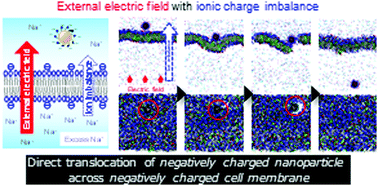Direct translocation of a negatively charged nanoparticle across a negatively charged model cell membrane†
Abstract
Nanoparticles have attracted much attention as a carrier for drug, gene, and macromolecule delivery in next-generation biomedical and therapeutic technologies. In delivery applications, nanoparticles tend to have negative charge due to the negative charge of biomolecules used as delivery cargo, while biological cell membranes are also negatively charged. This means that negatively charged nanoparticles (NC-NPs) are required to translocate across these negatively charged cell membranes (NC-CMs). However, this translocation is unlikely to occur because of electrostatic interactions. Here, we investigated the translocation of a NC-NP across a NC-CM under a transmembrane electric potential through coarse-grained molecular dynamics simulations. To model the transmembrane potential, two approaches were adopted: externally applied electric field and ionic charge imbalance. We showed that a NC-NP can directly translocate across a NC-CM via a non-disruptive pathway under a weak external electric field with an ionic charge imbalance. It was also found that the ionic charge imbalance contributes to the membrane crossing of a NC-NP as well as the self-resealing of the cell membrane after a NC-NP translocation. Our findings imply that NC-NPs can be delivered into a cell by combining applied electric field with membrane hyperpolarization/depolarization induced by an external stimulus.



 Please wait while we load your content...
Please wait while we load your content...